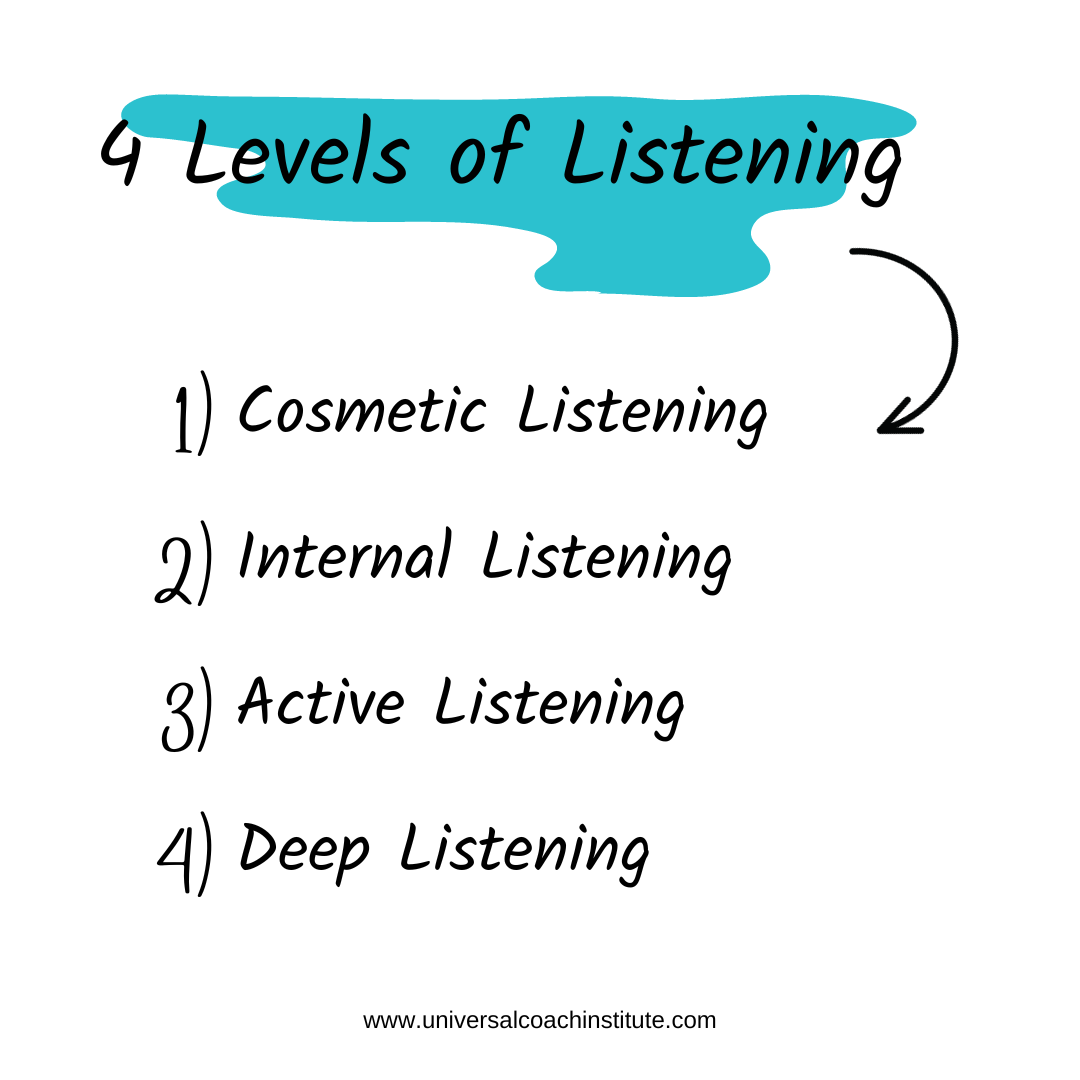Active listening is an essential skill in coaching.
It’s a game-changer in effective coaching.
It’s about immersing yourself in your client’s world, building trust, and encouraging open dialogue.
When actively listening, coaches can create impactful coaching experiences.
Beyond being a tool for understanding, active listening catalyzes self-reflection and growth for those being coached. It’s a powerful tool for connection and transformation.
In This Post
What is Active Listening in Coaching?
Active listening in coaching is when the coach attentively listens to both the spoken and unspoken words of the client.
It involves listening to comprehend the client’s perspective, not only for the benefit of the coach but, more importantly, for the client’s own sake.
Through active listening, the coach reflects back what the client has expressed. This allows the client to gain a fresh perspective on their own thoughts.
This enables the client to confirm, “Yes, that is exactly what I said,” or “Yes, that is precisely what I meant,” or even to clarify, “No, that’s not what I intended.”
When a client hears their own words, it brings a heightened sense of self-awareness.
How do you actively listen to clients and others?
Active listening in a coaching session is like a dance, where the coach and the client move in sync. One key move in this dance is mirroring.
Mirroring involves summarizing, paraphrasing, reiterating, reflecting feelings, and clarifying.
When used together, these techniques create a harmonious rhythm that elevates communication and fosters a deeper understanding between the coach and the client.
Mirroring
Summarizing
Summarizing is when the life coach gathers all the puzzle pieces their client has shared and puts them together. Summarizing confirms the coach’s understanding of the situation and clears any confusion. When a coach summarizes, it’s like saying, “Hey, your thoughts and feelings truly matter!” This fosters a deeper level of trust and communication between the coach and client.
Paraphrasing
Paraphrasing is when the coach rephrases what the client said but slightly differently. It’s where the coach takes the client’s words and gives them a gentle twist, shining a light on the hidden meaning within. It’s a technique that validates the client’s emotions and ensures a deep understanding of their message. Through paraphrasing, clients can uncover new insights and perspectives. It clarifies their thoughts and emotions and paves the way for problem-solving.
Reiterating
Reiterating involves the coach repeating back key phrases or words used by the client exactly as they were said. This technique underlines the importance of the client’s own language and expressions. It affirms their feelings and experiences. Additionally, it confirms that the coach is truly listening and comprehending the client’s point of view.
Reflection of Feelings
Reflection of feelings is when the coach acknowledges the client’s emotions and reflects them back. It’s like holding up a mirror to their feelings. This involves the coach identifying the underlying emotions the client is expressing. And then putting those emotions into words.
For example: “You sound very frustrated.” Doing this validates the client’s feelings and helps them better understand and accept their emotions.
Clarifying
Clarifying is when a coach ensures clear understanding and effective communication. It involves asking questions and seeking further details to ensure the coach fully comprehends. It prevents misinterpretations and reveals hidden aspects. It also facilitates a deeper exploration of the client’s situation. A coach can guide the client toward clearer thinking and effective decision-making by clarifying.
4 Levels of Listening
If you’re in a coaching session and not actively listening, what are you doing?
Well, you might be engaging in one of these other types of listening.
Let’s explore the 4 levels of listening.
Level 1 Cosmetic Listening: It’s when you pretend to listen, nodding along and saying things like “Yes,” “Uh-huh,” or “I hear you.” But if the speaker were to ask you a question, you’d be left clueless, unable to provide an answer.
Level 2 Internal Listening: It’s when we focus heavily on ourselves. We listen and analyze how the speaker’s words relate to our own situations.
Levels of Listening in Coaching
Level 3 Active Listening: It’s when your attention is sharply focused on the speaker. It involves understanding their message, comprehending the information, and responding thoughtfully. An added skill is the ability to take notes simultaneously, enhancing your engagement and retention.
Level 4 Deep Listening: It’s about being fully present and tuned in to the speaker. You’re laser-focused, giving your client your undivided attention. When you are deeply listening, you are unable to take notes. When you deeply listen, you’re unable to take notes. You’re not even mirroring. You’re fully engrossed in their story, seeking to understand them and genuinely connect. Deep listening is unintentional. It’s like you’re stepping into their shoes and experiencing what they’re going through.
In coaching, we transition between active listening and deep listening.
But here’s the secret: 80% of our listening should be active!
Why?
Because when we actively listen, we can fully utilize our coaching skills to propel the client and session forward.
So, while deep listening is okay, let’s not forget to embrace the power of active listening to make a real impact!
Quick Tips on How to Listen in a Coaching Session
- Pay Attention – Make eye contact as a sign that you are paying attention.
- Show that you understand – It can be by nodding or saying yes, mhhm, aha, or okay.
- Mirror – Respond to the client using a mirroring technique
- Ask an open-ended question – It can be a clarifying question, exploration question, powerful question, etc.
- Don’t Judge – Be open-minded, be a non-judgemental listener, and save your negative thoughts.
Take home message
Active listening is more than just hearing words; it’s about comprehending, responding, and engaging with the speaker in a meaningful way. As a coach, your listening skills can make or break your coaching sessions. Embrace the power of active listening, utilizing mirroring techniques to foster trust, validate emotions, and facilitate effective problem-solving. While deep listening has its place, remember to stay active 80% of the time to drive your sessions truly and your clients forward.
Happy coaching!







